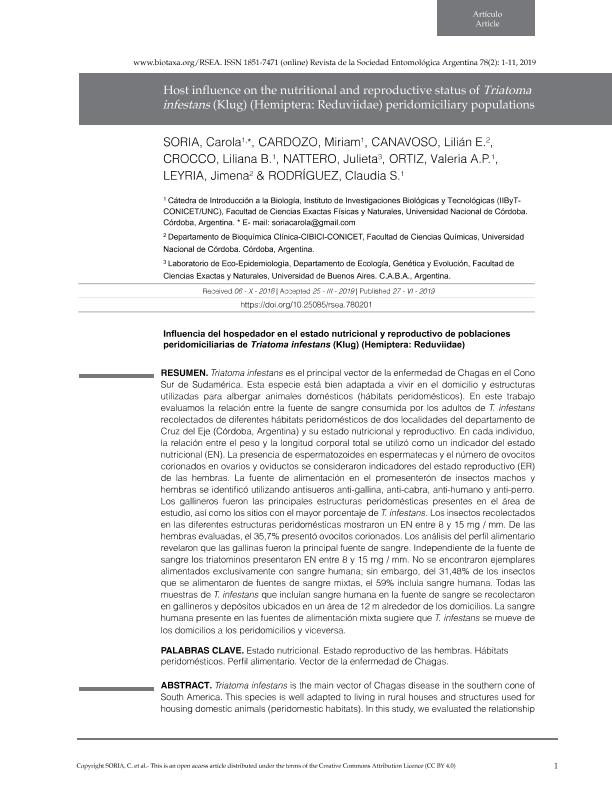Artículo
Triatoma infestans is the main vector of Chagas disease in the southern cone of South America. This species is well adapted to living in rural houses and structures used for housing domestic animals (peridomestic habitats). In this study, we evaluated the relationship between the source of blood consumed by adults of T. infestans collected from different peridomestic habitats from two localities from Cruz del Eje department (Córdoba, Argentina) and their nutritional and reproductive status. In each individual, the ratio between body weight and total body length was used as an indicator of nutritional status (NS). The presence of sperm in spermathecae and the number of chorionated oocytes in ovaries and oviducts were considered indicators of reproductive status (RS) of females. The feeding source in the promesenteron of male and female insects was identified using anti-chicken, anti-goat, antihuman and anti-dog antisera. Chicken coops were the main peridomestic structure present in the study area as well as the peridomestic sites with the highest percentage of T. infestans. Insects collected from the different peridomestic structures showed a NS between 8 and 15 mg/mm. Of the evaluated females, 35.7% presented chorionated oocytes. Food profile analyses revealed that chicken was the main blood source. Independently of the blood source, the triatomines presented a NS between 8 and 15 mg/mm. No specimens feeding exclusively on human blood were found; nevertheless, of 31.48% of insects feeding on mixed blood sources, 59% included human blood. All T. infestans specimens that included human blood in the mixed blood source were collected from chicken coops and storerooms located in a 12-m area around domiciles. Human blood present in mixed blood meal of adult insects suggests that T. infestans moves from domiciles to peridomicilies and vice versa. Triatoma infestans es el principal vector de la enfermedad de Chagas en el Cono Sur de Sudamérica. Esta especie está bien adaptada a vivir en el domicilio y estructuras utilizadas para albergar animales domésticos (hábitats peridomésticos). En este trabajo evaluamos la relación entre la fuente de sangre consumida por los adultos de T. infestans recolectados de diferentes hábitats peridomésticos de dos localidades del departamento de Cruz del Eje (Córdoba, Argentina) y su estado nutricional y reproductivo. En cada individuo, la relación entre el peso y la longitud corporal total se utilizó como un indicador del estado nutricional (EN). La presencia de espermatozoides en espermatecas y el número de ovocitos corionados en ovarios y oviductos se consideraron indicadores del estado reproductivo (ER) de las hembras. La fuente de alimentación en el promesenterón de insectos machos y hembras se identificó utilizando antisueros anti-gallina, anti-cabra, anti-humano y anti-perro. Los gallineros fueron las principales estructuras peridomésticas presentes en el área de estudio, así como los sitios con el mayor porcentaje de T. infestans. Los insectos recolectados en las diferentes estructuras peridomésticas mostraron un EN entre 8 y 15 mg / mm. De las hembras evaluadas, el 35,7% presentó ovocitos corionados. Los análisis del perfil alimentario revelaron que las gallinas fueron la principal fuente de sangre. Independiente de la fuente de sangre los triatominos presentaron EN entre 8 y 15 mg / mm. No se encontraron ejemplares alimentados exclusivamente con sangre humana; sin embargo, del 31,48% de los insectos que se alimentaron de fuentes de sangre mixtas, el 59% incluía sangre humana. Todas las muestras de T. infestans que incluían sangre humana en la fuente de sangre se recolectaron en gallineros y depósitos ubicados en un área de 12 m alrededor de los domicilios. La sangre humana presente en las fuentes de alimentación mixta sugiere que T. infestans se mueve de los domicilios a los peridomicilios y viceversa.
Host influence on the nutritional and reproductive status of Triatoma infestans (Klug) (Hemiptera: Reduviidae) peridomiciliary populations
Soria, Carola ; Cardozo, Miriam
; Cardozo, Miriam ; Canavoso, Lilian Etelvina
; Canavoso, Lilian Etelvina ; Crocco, Liliana Beatriz; Nattero, Julieta
; Crocco, Liliana Beatriz; Nattero, Julieta ; Ortiz, Valeria; Leyria, Jimena
; Ortiz, Valeria; Leyria, Jimena ; Rodriguez, Claudia Susana
; Rodriguez, Claudia Susana
 ; Cardozo, Miriam
; Cardozo, Miriam ; Canavoso, Lilian Etelvina
; Canavoso, Lilian Etelvina ; Crocco, Liliana Beatriz; Nattero, Julieta
; Crocco, Liliana Beatriz; Nattero, Julieta ; Ortiz, Valeria; Leyria, Jimena
; Ortiz, Valeria; Leyria, Jimena ; Rodriguez, Claudia Susana
; Rodriguez, Claudia Susana
Fecha de publicación:
27/06/2019
Editorial:
Sociedad Entomológica Argentina
Revista:
Revista de la Sociedad Entomológica Argentina
ISSN:
1851-7471
e-ISSN:
0373-5680
Idioma:
Inglés
Tipo de recurso:
Artículo publicado
Clasificación temática:
Resumen
Archivos asociados
Licencia
Identificadores
Colecciones
Articulos(CIBICI)
Articulos de CENTRO DE INV.EN BIOQUI.CLINICA E INMUNOLOGIA
Articulos de CENTRO DE INV.EN BIOQUI.CLINICA E INMUNOLOGIA
Articulos(IEGEBA)
Articulos de INSTITUTO DE ECOLOGIA, GENETICA Y EVOLUCION DE BS. AS
Articulos de INSTITUTO DE ECOLOGIA, GENETICA Y EVOLUCION DE BS. AS
Articulos(IIBYT)
Articulos de INSTITUTO DE INVESTIGACIONES BIOLOGICAS Y TECNOLOGICAS
Articulos de INSTITUTO DE INVESTIGACIONES BIOLOGICAS Y TECNOLOGICAS
Citación
Soria, Carola; Cardozo, Miriam; Canavoso, Lilian Etelvina; Crocco, Liliana Beatriz; Nattero, Julieta; et al.; Host influence on the nutritional and reproductive status of Triatoma infestans (Klug) (Hemiptera: Reduviidae) peridomiciliary populations; Sociedad Entomológica Argentina; Revista de la Sociedad Entomológica Argentina; 78; 2; 27-6-2019; 1-11
Compartir
Altmétricas



